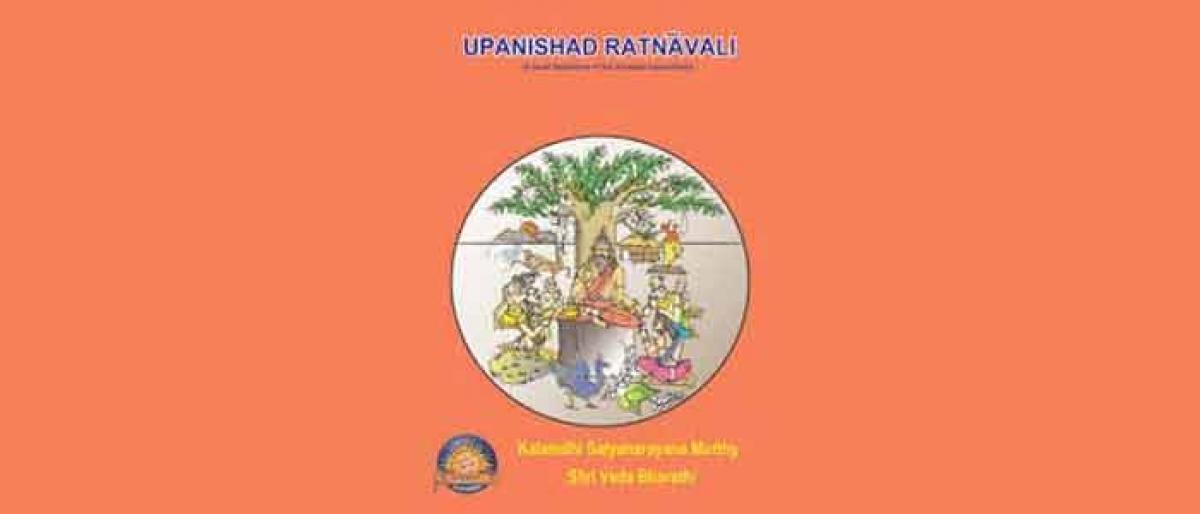Live
- Lara Dutta embraces depth over glamour
- Jagga Reddy condemns Eatala’s remarks on RaGa
- Around world, youth leading stir for ‘Climate Justice Now’
- Bandlaguda Jagir Corpn in Congress hands
- A thumbs up for India’s ascendance
- PG, BL semester exams begin at BRAU
- Malluravi is the Congress candidate who filed nomination in Nagar Kurnool
- Hanuman Jayanti 2024: Top Wishes, Quotes and Messages for Lord Hanuman's Birth
- Is the shooting of Ram Pothineni’s ‘Double iSmart’ really stopped?
- Ways to Please Lord Hanuman for Protection and Prosperity
Just In

Upanishads, whose origins date back to 800-400 BC, are perhaps the original form of Gurukuls, whereupon the teacher and pupils sit close to each other with the latter listening to doctrines in rapt attention. In a way, they form the nucleus of Indian philosophy and Upanishads (upa for ‘sitting close; and shad implying ‘sit’), per se, are central to Hinduism.
Upanishads, whose origins date back to 800-400 BC, are perhaps the original form of Gurukuls, whereupon the teacher and pupils sit close to each other with the latter listening to doctrines in rapt attention. In a way, they form the nucleus of Indian philosophy and Upanishads (upa for ‘sitting close; and shad implying ‘sit’), per se, are central to Hinduism.
Unfortunately, with the passage of time, the great ancient wisdom that was unique to India, started getting diluted because of flawed interpretations and misconceptions with only scholars and men of erudition having the access to Vedic education.
Even as one gets a glum picture over the downslide, here is an honest attempt by a very concerned individual who has come up with a painstaking, but worth the effort four-in-one compilation that makes the reader to revisit the Vedic days and know the inner self and the surroundings in all their pristine glory.
On should admire Klanidhi Satyanarayana Murthy, a retired Law Secretary to Government of Andhra Pradesh, whose bouquet of four exceptional works on essential contents of Upanishads are literary gems given the deftness with which he addresses the issue and comes up with deep-rooted substantiations that go on to make ‘Upanishad Ratnavali-a lucid exposition of the principal Upanishads, a must-have in every book-shelf.
That he has written the English version as well is indicative of his mastery over the subject and the language. In the first part contains the basic tenets of Hinduism and the challenges it is now facing, particularly with regard to Isavasyopanishad, Kenopanishad, all pervading Brahmam, Atman, life and re-birth, control over emotions and organs each of which are eternally relevant.
The second decodes Mundakopanishad, Prasnopanishad and Taitriyopanishad, which are elaborately explained in different chapters and under numerous sub- heads. Part three elaborates about Chandogyopanishad, Aitereyopanishad and Kathopanishad with the first perceived as the second largest in size after Brihadaranyaka Upanishad.
In the final part, the thought-provoking wisdom in the voluminous Brihadaranyakopanishad, Mandukyopanishad, and Svetasvetaropanishad are dwelt in detail and makes for simple writing. Though small in size, Munadukya Upanishad contains the essence of Vedanta in its entirety. All the observations are dealt appropriately in this part.
It is not just the content, its author’s genius that will hold the reader, who will be compelled to complete the reading in one go. A great legacy that he leaves behind is the manner Satyanarayana Murthy has interpreted them with examples taken from the modern life.
Right from Big Bang theory to ‘Razor’s Edge’, he has connected the essence of Upanishads with our lives. Swami Vivekananda’s clarion call of ‘Arise! Awake and stop not till the goal is traced to Kathopanishad. Murthy points out that scientists, western scholars, philosophers and writers have been influenced by the Upanishads, which speak about the compelling need for a sustained green revolution with the magical words ‘Annam bahu kurvita tad vratam’. The author has done well with his easy-to-understand language while extolling about the relevance of Upanishads.
Buoyed by the tremendous to the Telugu original, the author is reaching out to a larger audience with the translated version that also hands the complex subject deftly. The reader will understand that Satyanarayana Murthy is a true-blue narrator of the Upanishads. A word of praise ought to go to Dr Remella Avadhanulu, the editor of the book, whose product as inspirational.
By: DR G BALAKRISHNA

© 2024 Hyderabad Media House Limited/The Hans India. All rights reserved. Powered by hocalwire.com







